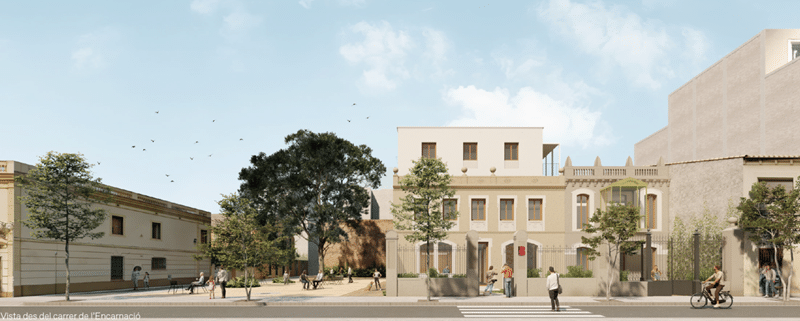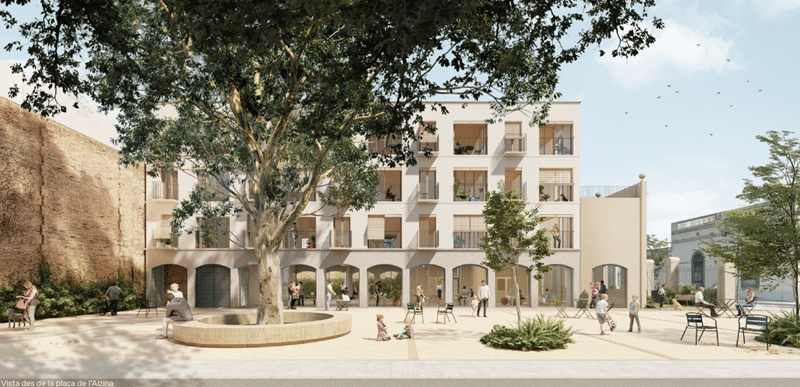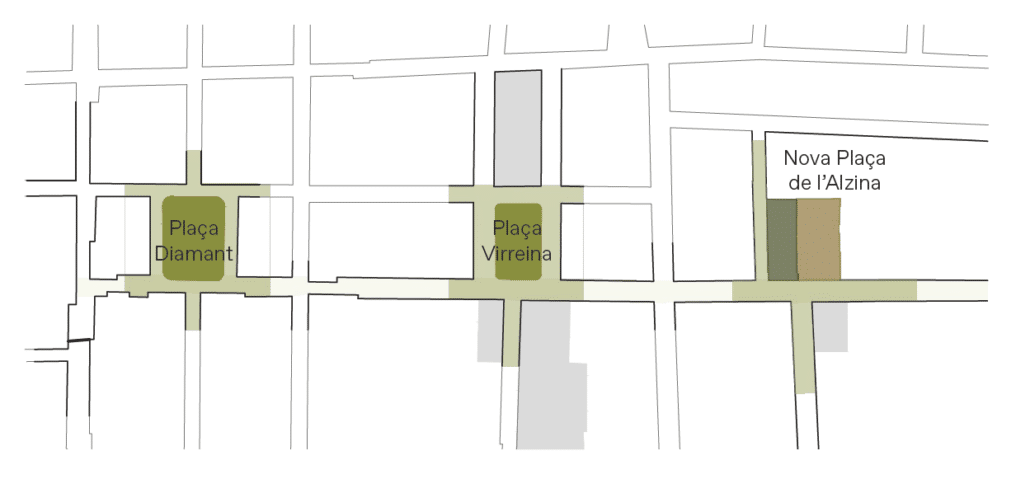Vila de Gràcia, one of Barcelona’s most iconic neighborhoods, is preparing for an urban transformation that goes far beyond a simple architectural intervention. In one corner of this vibrant neighborhood, the old Casetes d’Encarnació, at the intersection with Manrique de Lara, is about to be reborn under the slogan “La plaça del Quercus”. This winning project, presented by UTE de arquitectes IMAHB Encarnació, brings with it a change that not only respects the past, but also points to a more sustainable and livable future for residents.
 A renovated space for the community
A renovated space for the community
The heart of this project is the creation of a new public square that will surround the historic bicentennial alzina. This tree has not only witnessed the passage of time, but will now become the center of a larger and more accessible space, free from the walls that have so far enclosed the Alzina garden. With this proposal, the emblematic alzina will gain in visibility and centrality, integrating seamlessly into the network of squares in Gràcia that includes Virreina and Diamant. The square will not only be a place for enjoyment, but will also allow for greater connection within the neighborhood, creating a new transit route between Montmany and Manrique de Lara. The configuration of the space has been carefully designed: a rectangular square that, on its long side, will face Manrique de Lara and, on the short side, Encarnació. This layout is no coincidence, as it seeks to protect the roots of the bicentennial alzina, one of the most important natural elements of the area.
Sustainable and conscious design
One of the highlights of this project is its focus on sustainability. The paving of the plaza will be 100% drainable, allowing rainwater infiltration, which is vital in a city that must face the challenges of climate change. In addition, the existing trees will be maintained and new native species that do not require additional irrigation will be planted using a xeriscaping system. The incorporation of water harvesting and filtration technologies is another key point of the project. The resulting plaza and garden will not depend on external water for maintenance, which is an important contribution to environmental sustainability in a densely populated urban environment.
 Accessible and functional housing
Accessible and functional housing
In addition to the square, the project also includes the construction of a new building that will house 15 public housing units and a center for the elderly on the first floor. This new building will be integrated into the surroundings while maintaining the alignment with the historic façade, which will be preserved as stipulated in the competition. It will have a height of first floor plus three floors, respecting a distance of four meters from the original facade of the Casetes. The layout of the dwellings also reflects a modern and flexible approach. All dwellings will have two bedrooms of equal size, allowing for greater versatility in their use and adapting to different types of family units. In addition, the building will include common areas to encourage socialization among residents, such as an interior courtyard with bicycle parking and a communal terrace on the second floor. This design promotes a more active and connected community life, something that can be especially valuable in a city where life often takes place in small individual apartments. Another important feature is the building’s configuration as a single compact volume, with through typologies that ensure cross ventilation. This, together with the design aimed at making the most of natural light, will contribute to improving energy efficiency and the comfort of the inhabitants.
 An ongoing process
An ongoing process
The selection of the winning proposal is only the first step in a process that still has several stages ahead. Now begins the phase of drafting the basic project and the executive project, which will define the details of the construction. In addition, the new urban planning will be processed to adapt the project to the current configuration of the area. One of the most important points will be the preservation of the facade of the Casetes d’Encarnació, which will be maintained as a reminder of the architectural heritage of the area. This project, in addition to creating new housing, responds to the need to protect the historical and natural legacy of Gràcia. The preservation of the alzina and the façade are symbols of a commitment to the memory of the neighborhood, but also to its future.
The importance of the project for Barcelona
This project has a double importance: on the one hand, it will protect and give visibility to a unique natural heritage such as the alzina, and on the other hand, it will provide new public housing in one of the densest areas of the city. Gràcia is known for its compact character and lack of space for new construction, so every project that adds affordable housing is crucial. The first deputy mayor for Urbanism, Ecological Transition, Urban Services and Housing, stressed that this project responds to the need to make heritage accessible to the community. It is not only about protecting a space, but transforming it so that neighbors can enjoy it. He also stressed the importance of increasing the public housing stock in a city like Barcelona, where access to housing is one of the main problems. The Housing Commissioner, for his part, recalled that access to housing is the number one priority for the City Council. This project, along with others being carried out throughout the city, reflects the municipal government’s efforts to increase the supply of affordable housing and prevent citizens from being forced to leave their neighborhoods for lack of options.
A project that looks to the future
The Casetes d’Encarnació project is not just an architectural intervention, it is a statement of intent on how Barcelona can grow in a way that is sustainable and respectful of its history. By combining heritage protection with the creation of new public spaces and affordable housing, Barcelona City Council is taking an important step towards a more livable and accessible city for all. Although construction is still a few years away, this project has already generated expectations among the residents of Gràcia and among those who closely follow the city’s evolution. Barcelona continues to invest in projects that not only transform the urban landscape, but also improve the quality of life of its citizens.


 A renovated space for the community
A renovated space for the community Accessible and functional housing
Accessible and functional housing An ongoing process
An ongoing process
